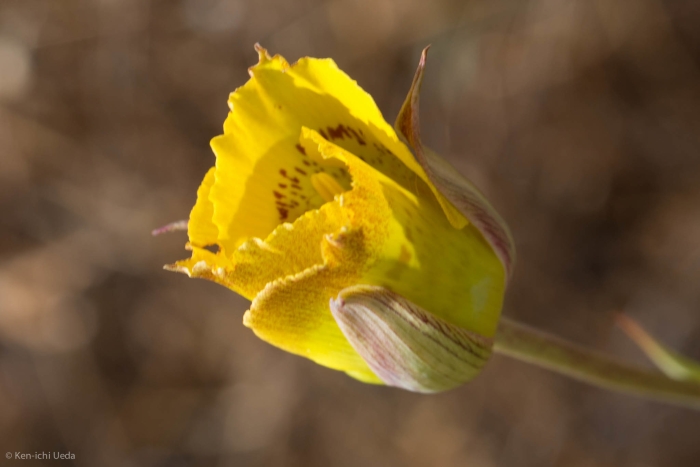Yellow Mariposa Lily
(Calochortus luteus)
Yellow Mariposa Lily (Calochortus luteus)
/
/

Ken-ichi Ueda
CC BY 4.0
Image By:
Ken-ichi Ueda
Recorded By:
Copyright:
CC BY 4.0
Copyright Notice:
Photo by: Ken-ichi Ueda | License Type: CC BY 4.0 | License URL: http://creativecommons.org/licenses/by/4.0/ | Rights Holder: Ken-ichi Ueda | Publisher: iNaturalist | Date Created: 2016-05-22T16:53:16-07:00 |

























Estimated Native Range
Summary
Calochortus luteus, commonly known as the Yellow Mariposa Lily, is a perennial herb that is endemic to California. It thrives in various habitats including coastal prairies, grasslands, and open forest floors, particularly in areas from northern Santa Barbara County to the Sierra Nevada foothills. This species is recognized for its bright, deep yellow cup-shaped flowers, which are 1-2 inches across and often feature red-brown blotches on the inside. The flowering season typically occurs in late spring to early summer, and the flowers are quite showy, attracting pollinators such as bees and butterflies.
The Yellow Mariposa Lily is valued in cultivation for its striking flowers and its ability to adapt to a range of garden settings. It is often used in landscaping and restoration projects, where it adds a splash of color and contributes to local biodiversity. Gardeners appreciate its drought tolerance once established, making it suitable for xeriscaping and native plant gardens. It prefers full sun to light shade and requires well-drained soils. While generally low-maintenance, it can be susceptible to bulb rot if overwatered or planted in poorly drained soils. It is available from native plant nurseries for ornamental use, and while it does not have aggressive roots, it should be planted with care to avoid disturbing the bulbs.CC BY-SA 4.0
The Yellow Mariposa Lily is valued in cultivation for its striking flowers and its ability to adapt to a range of garden settings. It is often used in landscaping and restoration projects, where it adds a splash of color and contributes to local biodiversity. Gardeners appreciate its drought tolerance once established, making it suitable for xeriscaping and native plant gardens. It prefers full sun to light shade and requires well-drained soils. While generally low-maintenance, it can be susceptible to bulb rot if overwatered or planted in poorly drained soils. It is available from native plant nurseries for ornamental use, and while it does not have aggressive roots, it should be planted with care to avoid disturbing the bulbs.CC BY-SA 4.0
Plant Description
- Plant Type: Herb, Bulb
- Height: 1-2 feet
- Width: 0.5-1 feet
- Growth Rate: Moderate
- Flower Color: Yellow
- Flowering Season: Spring, Summer
- Leaf Retention: Deciduous
Growth Requirements
- Sun: Full Sun, Part Shade
- Water: Low
- Drainage: Medium, Fast
Common Uses
Butterfly Garden, Edible*Disclaimer: Easyscape's listed plant edibility is for informational use. Always verify the safety and proper identification of any plant before consumption., Low Maintenance
Natural Habitat
Coastal prairies, grasslands, and open forest floors in California
Other Names
Common Names: Gold Nuggets
Scientific Names: , Calochortus luteus, Calochortus luteus, Cyclobothra lutea, Mariposa lutea,
GBIF Accepted Name: